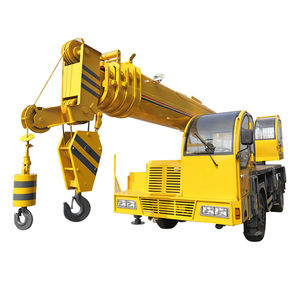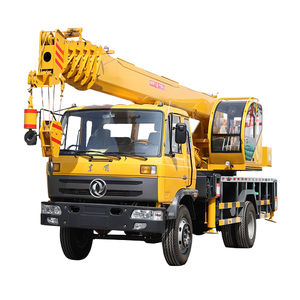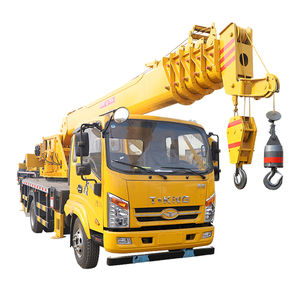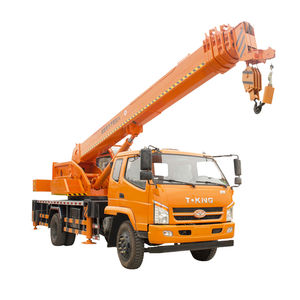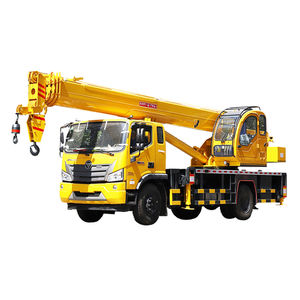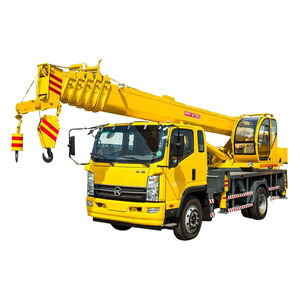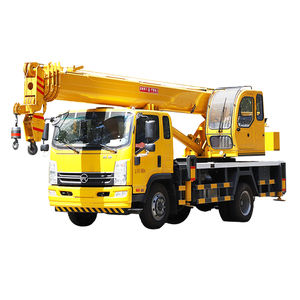
- Packing - Handling - Logistics
- Handling and Lifting
- Crawler crane
- Shandong Hengwang Group Co., Ltd.
- Company
- Products
- Catalogs
- News & Trends
- Exhibitions
Crawler crane HWQY6Tconstructionunloadinglifting


Add to favorites
Compare this product
Characteristics
- Configuration
- crawler
- Operating environment
- construction
- Applications
- lifting, unloading, handling
- Engine type
- diesel
- Lift capacity
6 t
(6.6 us ton)- Working height
25 m, 28 m
(82'00" , 91'10" )- Drive engine power
74 kW
(101 hp)- Width (base)
2 m
(6'06" )- Length (base)
7.2 m
(23'07" )- Total weight
6,500 kg
(14,330 lb)
Description
Crane is a colloquial term for a lifting machine, and a crane is a type of lifting machinery that performs cyclic and intermittent movements. A working cycle includes: the grabbing device lifts the item from the pickup location, then moves horizontally to a designated location to lower the item, then reverses the motion to return the grabbing device to its original position for the next cycle. Examples include fixed rotary cranes, tower cranes, mobile cranes, tire cranes, and track cranes.
It is a multi-action lifting machinery that vertically lifts and horizontally transports heavy objects within a certain range. Also known as a crane, it belongs to material handling machinery. The working characteristic of a crane is intermittent motion, meaning that the corresponding mechanisms for actions such as picking up materials, moving, and unloading work alternately in one working cycle.
Cranes are widely used in places such as ports, workshops, power plants, and construction sites for lifting and transporting machinery. The term "crane" is a unified name for lifting machinery. Typically, the main types referred to as cranes are mobile cranes, crawler cranes, and tire cranes. The purpose of cranes is for hoisting equipment, emergency rescue, lifting, machinery, and rescue operations.
Product features:
1. Wide range of applications, simple structure, smooth transmission, labor-saving operation, easy to achieve automation control.
2. Suitable for complex road conditions such as swamps, riverbanks, deserts, paddy fields, tropical rainforests, snow, and ice.
3. Single-cylinder power system, low fuel consumption, can also use dual-cylinder, four-cylinder diesel engines.
Catalogs
No catalogs are available for this product.
See all of Shandong Hengwang Group Co., Ltd.‘s catalogsExhibitions
Meet this supplier at the following exhibition(s):

bauma CHINA 2024
26-29 Nov 2024 Shanghai (China) Hall Shanghai New International Expo Centre - Stand D-70
More information

Big 5 Global
26-29 Nov 2024 Dubai (United Arab Emirates) Hall Dubai World Trade Centre - Stand OS 860
Other Shandong Hengwang Group Co., Ltd. products
Truck Crane
Related Searches
- Hengwang crane
- Hengwang forklift
- Hengwang aerial work platform
- Hengwang walk-behind forklift
- Hengwang mobile crane
- Hengwang lifting crane
- Mobile lift platform
- Boom crane
- Hengwang handling forklift
- Hengwang construction crane
- Electric forklift truck
- 4-wheel forklift truck
- Hengwang combustion engine forklift
- Hengwang hydraulic crane
- Telescopic crane
- Hengwang truck-mounted crane
- Hengwang industrial forklift
- Scissor lift platform
- Hengwang diesel forklift
- Mobile scissor lift platform
*Prices are pre-tax. They exclude delivery charges and customs duties and do not include additional charges for installation or activation options. Prices are indicative only and may vary by country, with changes to the cost of raw materials and exchange rates.




